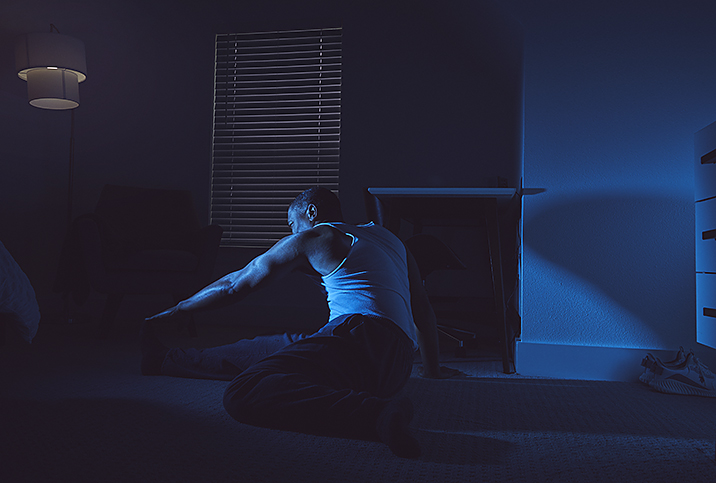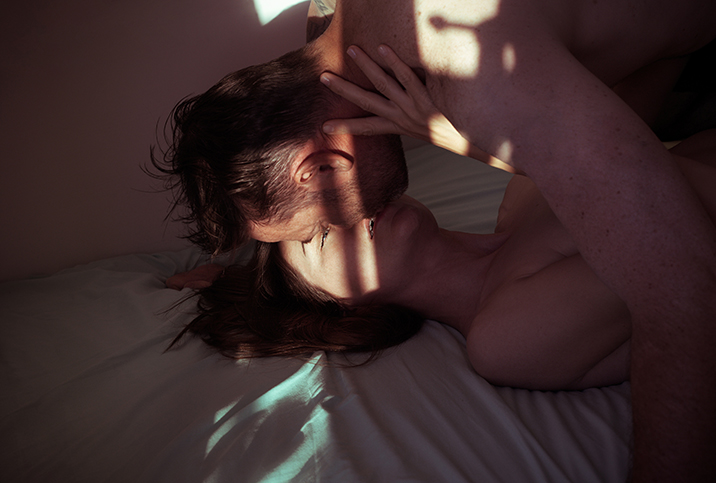The Perks of Adding Exercise to Your Sleep Routine

For years, the theory prevailed that exercising too close to bedtime would prevent you from getting solid sleep. On the surface, it makes sense. If you're hot and sweaty, and your body just got "woken up" by a good workout, logically it's going to be harder to fall asleep, right?
Luckily, science often does a good job of debunking popular, unverified hypotheses.
Numerous studies have addressed the effects of pre-sleep exercise, and with a few caveats, have indicated it's not a problem when it comes to hitting the hay. Exercise performed at any time of the day (including right before bed) can help you sleep better.
Exercise promotes sleep quality
Exercise and sleep are two healthy habits that go hand-in-hand. The more consistently you exercise, the better your sleep ends up being, and the more often you enjoy high-quality sleep, the more energized and ready you'll feel to exercise.
"Exercise can promote more N3 sleep—that's deep NREM sleep," said Joseph Krainin, M.D., president and founder of Singular Sleep, LLC, and fellow of the American Academy of Sleep Medicine. "This stage of sleep is the most 'restorative' of the stages of sleep, leading to the refreshing feeling we get in the morning after a good night's rest."
While Krainin admits the historic view was to avoid more vigorous exercise before bed, he acknowledges the theory has since been debunked.
"A few years ago, a research study looked specifically at this [theory] and found that exercising before bed did not negatively impact sleep quality," he said.
The study he referenced, which was published in a 2019 edition of the journal Sports Medicine, reviewed 23 other studies that indicated, as a whole, nighttime exercise helped sleep, rather than hurt it. Evening exercise was associated with increased rapid eye movement latency and slow-wave sleep, and it decreased stage 1 sleep. Together, these factors point to more restful and restorative sleep.
Always an exception or two
All you night owls out there who've been hitting the gym at 10 p.m. or later for years can finally feel justified in your choice. Most likely your commitment to exercising, regardless of the time of day, has paid off for your overall well-being. However, there are a couple of things to keep in mind about the type of exercise you perform close to bedtime.
"If the only time you can exercise is later in the evening, then have at it," Krainin said. "Moderate-intensity cardio is great, weight training a few days a week is good, and stretching is also helpful for long-term health. I probably would avoid high-intensity interval training as you're going to ramp your nervous system up so high, so quickly, that it will likely make it harder to fall asleep."
The Sports Medicine review study confirms this assertion, in which it reported higher-intensity exercise performed shortly before bed was associated with lower sleep efficiency and more periods of wakefulness after falling asleep.
Exercise intensity certainly plays a role when it comes to pre-sleep exercise, but timing is important, too. A 2021 review study published in Sleep Medicine Reviews found high-intensity exercise that ended at least two hours before bedtime carried positive sleep effects, while high-intensity exercise performed within two hours of bedtime interfered with sleep quality.
When you're exercising before bed, here's your prescription
To review: Exercise is good, sleep is good and doing both is important. If your schedule only allows for you to exercise in the two hours before you lay down to sleep, you shouldn't skip your workout to "sleep better." Quite the opposite, in fact. You just likely need to avoid doing a workout that's too intense.
Here are some ideas to best add exercise to your nighttime routine.
Yoga and meditation
"For restful sleep, it's necessary to facilitate a nurturing context," said Erica Sergott, Noom Coach and certified yoga and meditation instructor. "Doing so gives our whole being the permission to transition from activation into release. A series of supportive movements, simple relaxation breathing techniques and a calming environment can counterbalance (even neutralize) that oh-so-unholy stress trifecta of mental, physical and emotional stress."
Specifically, Sergoff said modern, daily life can lead to chronic tightness and tension in the back, diaphragm and hips. Using a series of yoga poses that helps ease the tightness and releases tension can make it easier to rest comfortably in bed for a good night's sleep. That said, she suggests finishing the series at least an hour before bed, if you can. And if not?
"Consider wrapping up your practice with a couple of restorative poses, deep breathing and an extended savasana (a relaxed, lying position) to prep your body and brain for sleep," she advised. "Avoid poses like arm balances and core exercises that fire up your neurons and the heat-producing center of the body."
She also noted that if you're going to follow a practice online, or if you're thinking of in-person classes at a studio, you should look for grounded, slow routines, or styles of yoga, such as restorative yoga, yin yoga, yoga nidra and slow flow.
For a step-by-step practice from Sergoff, perform the following:
- Bedside chest-opener with deep breathing: Stand next to your bed, interlace your fingers behind you, and squeeze your shoulder blades together. Breathe deeply for several breaths. If you want to deepen the stretch, bend the knees slightly and hinge from the hips into a forward bend. Allow your head and neck to release by slightly tucking your chin to your chest. After several breaths, release your hands and slowly roll upright until you arrive at a standing position.
- Seated cat-cow: Sit cross-legged in bed. Interlace your fingers behind your head. Draw your elbows wide, squeezing the shoulder blades together. Pull your navel to your spine, slightly arching back, then rounding forward, bringing the elbows toward each other. Repeat this seated cat-cow movement five times.
- Seated hip release and chest stretch: Uncross your legs, plant your feet on the mattress with bent knees. Place your hands behind you and lean back slightly. Sway your knees gently from side to side while you open your chest.
- Deep breaths: Lie flat on your belly and breathe deeply, feeling your belly expand into the bed and relax away with your inhales and exhales. Continue for about a minute.
- Side-lying hip and quad stretch: Roll to one side and stack your legs on top of each other, using your arm as a support for your head and neck. Bend your top leg at the knee and draw your heel toward your glute. Feel the stretch at the front of your thigh and into your hip. Use your hand to reach back and draw your heel closer to your glute. After several deep breaths, release and repeat to the opposite side.
- Lying banana side-stretch: Roll to your back and stretch your arms overhead, clasping your hands together. Bend your torso to the right side, so you feel a stretch along the left side of your body. Breathe deeply five times, then return to center and repeat to the opposite side.
- Reclined pigeon pose hip-release: Lie flat on your back. Bend your knees and plant your feet on the mattress. Cross your right ankle over your left knee, then flex your right foot, and lift your left foot from the mattress, opening your right outer hip. After five deep breaths, switch sides.
- Easy supine spinal twist: Hug your knees to your chest, then release both knees to your right side, until your right outer thigh is touching (or almost touching) the mattress. Open your arms out to a "T" position and look over your left shoulder if you'd like a deeper stretch. Hold for five breaths before returning to center and repeating on the opposite side.
- Knee hug: Draw both knees to your chest and hug them close. Hold the position for five breaths, then release your legs fully so you're lying flat on your back.
- Savasana: Finish your routine with the "dead man's" pose. Lie on your back, and if you'd like, place a pillow under the back of your knees for support. Rest one hand on your heart and one hand on your belly. Breathe deeply, feeling your abdomen expand into your hands. Continue as you allow your exhales to extend longer than your inhales, guiding your mind to a place of relaxation.
A more traditional workout
If yoga isn't your thing, you can try a more "traditional" workout and still not worry about how it'll interfere with your sleep.
"Finding time to exercise and getting a good night's sleep is difficult for people who are on the go," said Kristen Marotte, an Atlanta-based certified personal trainer and pilates instructor at Life Time Fitness. "For a late evening workout that'll prepare you for sleep, try a workout with 15 to 20 minutes of cardio and 15 to 20 minutes of bodyweight resistance followed by 15 to 12 minutes of mindful stretching. Treat stretching as part of your bedtime routine. Create a relaxing environment away from distractions like electronic devices and begin the process of winding down both mentally and physically."
As a whole, this can be as simple as:
- Five minutes of slow, steady-state walking to warm up
- 15 minutes of gradually increasing cardio, increasing your intensity to a seven or eight, on a self-perceived intensity scale of one to 10 (one being sitting still, 10 being an all-out sprint)
- A five-move, 15-minute strength training circuit. Perform each exercise for a minute, completing three total rounds:
- Bodyweight squats
- Incline pushups on a bench or the back of a couch
- Side lunges, alternating sides
- Dumbbell renegade rows (performed on your knees as a modification)
- Dead bugs
Follow this workout with a 10-move stretch targeting every major muscle group, holding each stretch for one minute (or 30 seconds per side, if it's a unilateral stretch):
- Standing chest-opener
- Overhead triceps stretch (30 seconds per side)
- Cross-body shoulder stretch (30 seconds per side)
- Standing quad stretch (30 seconds per side)
- Standing hip-flexor stretch (30 seconds per side)
- Standing calf stretch (30 seconds per side)
- Forward fold
- Cat-cow stretch on your hands and knees
- Lying knee-to-chest stretch (30 seconds per side)
- Savasana
Add exercise to your day for all the important benefits
The benefits of exercise reach far beyond how it makes you look or whether it reduces your risk for heart disease. Exercise has a ripple effect of positive impacts that play out in all areas of your life.
"Exercise is great life-training," Marotte said. "The act of putting your muscles (including your heart) under regular stress and learning to recover has benefits that reach far beyond the physical body. The cycle of training directly correlates to the mental ability to perform and recover from emotional stress. One without the other is an imbalance."
And if lowering stress can help you sleep better, and good sleep can help you mentally and physically, it's simply proof that one good habit can create a domino effect that promotes healthy living in all areas of your life.


















